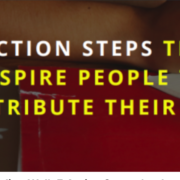3 Action Steps that help your subordinates overcome their fear of making decisions
“I want my subordinates to make decisions,” Jim told me, “but they keep asking for permission.”
Why is that so bad, I asked him, you know they won’t make a wrong decision.
“The problem is that the decisions keep piling up on my plate. It’s like the salad bar at Olive Garden. Before you know it, you’ve got a mound of everything, and you lose your appetite for the main course. I feel like I can never get to the main course.”
Greens can be good for you.
“The problem is that I need to make my decisions – that’s the main course. My decisions are getting cold and stale because I’m choking on the salad bar. We’re losing opportunities because I’m in the weeds.”
That makes sense. What have you done to encourage your subordinates to make decisions?
“I tell them that’s what I want them to do. They nod in agreement. An hour later, the emails come in asking me permission to do this, that, and the other thing.”
What happened the last time someone made a poor decision?
“I kinda lost my mind.”
Does this conversation sound familiar?
I’ve had a version of it three times in the past week, which is why I’m writing this article for you.
The COVID pandemic and economic uncertainty have made people even more risk-averse.
Decisions that your direct reports should be making are piling up on your plate and reducing your bandwidth to do your job.
Here are three action steps that will help you boost people’s confidence to make decisions.
1. Define the decision-space. Have your direct reports outline the scope of their decision-making authority and boundaries. Discuss and refine. You’ll be able to reinforce the shared commitment to your common purpose as you do so.
2. Set the expectations. Every time you lose your mind when someone makes an honest mistake, you discourage initiative.
Let people know how you will respond if a decision they make does not work out well.
If it’s a mistake of commission – someone erred when trying to do the right thing – then you need to underwrite the error and coach.
Underwriting the mistake will sustain their confidence that you won’t throw them under the bus. Coaching will help your subordinates learn from the experience.
A mistake of omission – laziness, ethical short-cuts, etc. – deserves punishment.
Walk your talk.
3. Practice. Rehearse the decisions and your responses if things go well or go poorly. When someone tries to put the ball in your lap, give it back to them, and review steps 1 and 2.
What’s your top takeaway about encouraging people to make decisions?
Let me know with a comment or email at chris@strategicleadersacademy.com











